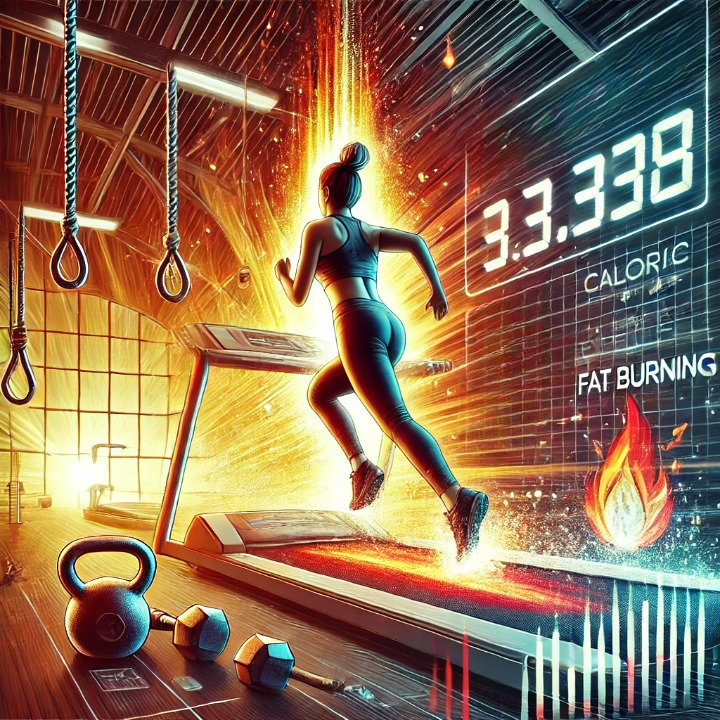When it comes to fitness, efficiency is often a top priority. Many people are looking for ways to get the most out of their workouts in the least amount of time.
Full body workouts have gained popularity as a solution, but are they truly effective? What kind of results can you expect from full body workouts into your routine?

Whether you're a fitness enthusiast or someone just starting out on your fitness journey, understanding the effectiveness of full body workouts can help you make informed decisions about your training regimen.
This blog post dives deep into the concept of full body workouts, exploring the benefits, potential results, and how you can maximize your gains.
So, are full body workouts effective? And what results can you realistically expect? Let's explore these questions in detail and uncover the truth about full body training.
What Are Full Body Workouts?
Definition and Basic Concept
Full body workouts are exactly what they sound like—workouts that target multiple major muscle groups in a single session. Unlike split routines, where you might dedicate one day to legs and another to arms, full body workouts engage various parts of your body within the same workout.
This approach allows you to train your entire body more frequently, which can be particularly beneficial for those with limited time.
Example: A typical full body workout might include exercises like squats, deadlifts, bench presses, and rows. These movements are compound exercises, meaning they work multiple muscle groups at once.
For instance, squats target your quads, hamstrings, glutes, and even your core. By incorporating compound exercises, full body workouts help you maximize your time at the gym while ensuring all major muscle groups are activated.
Examples of Full Body Workouts
To give you a better idea of what a full body workout might look like, here’s a sample routine:
- Warm-Up (5-10 minutes):Light cardio (e.g., jogging or cycling) followed by dynamic stretching.
- Exercise 1: Squats (3 sets of 10-12 reps):Targets the legs and core.
- Exercise 2: Bench Press (3 sets of 8-10 reps):Engages the chest, shoulders, and triceps.
- Exercise 3: Deadlifts (3 sets of 6-8 reps):Works the lower back, hamstrings, and glutes.
- Exercise 4: Bent-Over Rows (3 sets of 8-10 reps):Focuses on the back and biceps.
- Exercise 5: Overhead Press (3 sets of 8-10 reps):Targets the shoulders and upper chest.
- Cool Down (5-10 minutes):Stretching and light cardio to bring your heart rate down.
This routine covers all the major muscle groups in a single session, providing a comprehensive workout that can be completed in under an hour. It’s also versatile; you can adjust the intensity and volume to match your fitness level or goals.
The Benefits of Full Body Workouts
Full body workouts offer several advantages that make them an appealing choice for many fitness enthusiasts. From time efficiency to improved calorie burn, here’s why full body workouts might be the perfect addition to your fitness routine.
Efficiency and Time-Saving
One of the most significant benefits of full body workouts is their efficiency. In our busy lives, finding time to exercise can be challenging.
Full body workouts address this by allowing you to train multiple muscle groups in a single session. Instead of spending five days a week at the gym focusing on different body parts, you can achieve similar or even better results by working out three times a week with full body sessions.
Example: If you're following a split routine, you might spend one day on chest and triceps, another on back and biceps, and so on. This can lead to five or six gym sessions per week.
With full body workouts, you can reduce your gym visits while still engaging all muscle groups, saving time without sacrificing results.
Improved Calorie Burn
Full body workouts are also effective for those looking to burn calories and lose weight. Since you’re working multiple large muscle groups simultaneously, your body requires more energy, leading to a higher caloric expenditure during and after the workout.
This is often referred to as the "afterburn effect" or Excess Post-exercise Oxygen Consumption (EPOC), where your body continues to burn calories even after the workout is finished.
Comparison: When comparing full body workouts to split routines, full body sessions tend to burn more calories per workout.
For example, doing a combination of squats, deadlifts, and bench presses will typically burn more calories than focusing on isolated exercises like bicep curls or leg extensions.
Enhanced Muscle Recovery
Another benefit of full body workouts is their impact on muscle recovery. When you train your entire body in one session, you give each muscle group more time to recover before the next workout.
This balanced approach reduces the risk of overtraining specific muscles, which can lead to injury or burnout.

Example: If you follow a traditional split routine, you might work your chest on Monday and arms on Tuesday. If you over train your chest, it might still be sore when you try to work your arms, affecting your performance and recovery.
With full body workouts, your chest, arms, and other muscle groups get ample recovery time between sessions.
Tip: To optimize recovery, it's essential to incorporate proper nutrition and rest. Ensure you're consuming enough protein and getting adequate sleep to support muscle repair and growth.
Versatility and Flexibility
Full body workouts offer a high degree of versatility, making them suitable for various fitness goals, whether you're aiming to build muscle, lose fat, or increase strength. They can be easily adapted to different fitness levels, from beginners to advanced athletes.
Adaptability: Beginners can start with lighter weights and fewer sets, gradually increasing the intensity as they become more comfortable with the exercises. Advanced lifters can add more sets, incorporate supersets, or use advanced techniques like drop sets to challenge their muscles further.
Flexibility: Full body workouts can also be performed virtually anywhere, from the gym to your living room. With the right equipment—such as dumbbells, resistance bands, or even bodyweight exercises—you can maintain a comprehensive full body workout routine without needing access to a full gym.
Internal Link: If you're looking for more guidance on home workouts, check out our article on The Ultimate Guide to Tabata Workout: Benefits, Routines, and Tips for Effective HIIT Training.
Are Full Body Workouts Effective for Building Muscle?
Building muscle is a common goal for many who engage in regular exercise, and full body workouts can be an effective method for achieving this. However, understanding the dynamics of muscle growth and how full body workouts play a role is crucial for maximizing your gains.
Muscle Growth Potential
Full body workouts stimulate muscle growth by engaging multiple muscle groups during each session. This frequent stimulation can lead to more significant hypertrophy, especially when combined with proper nutrition and recovery.
Mechanism: Muscle growth, or hypertrophy, occurs when muscle fibers are subjected to stress, causing micro-tears. The body repairs these tears, leading to an increase in muscle size and strength. Full body workouts provide consistent stress across various muscle groups, ensuring that no area is neglected.
Comparison: When comparing full body workouts to split routines, the former may offer an advantage in muscle growth for beginners and intermediates. Research suggests that training a muscle group multiple times a week (as with full body workouts) can lead to more hypertrophy compared to training each muscle group only once a week, as often seen in split routines.
Frequency vs. Volume
Understanding the balance between workout frequency and volume is key to maximizing muscle growth. Frequency refers to how often you train, while volume is the total amount of work performed (sets x reps x weight).
Balance: In full body workouts, the frequency is typically higher, with workouts scheduled 2-4 times a week. This allows each muscle group to be worked multiple times a week, which is beneficial for muscle hypertrophy. However, the volume per session is usually lower compared to split routines, where more exercises and sets are dedicated to specific muscle groups.
Example: In a split routine, you might perform 4-5 exercises for your chest in one session, leading to a high volume workout. In contrast, a full body workout might include only 1-2 chest exercises per session, but these are repeated several times a week, resulting in a similar total volume.
Strategy: To maximize results with full body workouts, it’s essential to find the right balance between frequency and volume. For most people, a moderate frequency (3 times per week) with moderate volume (3-4 sets per exercise) is effective for muscle growth.
Here’s a simple comparison of frequency and volume between full body workouts and split routines:
| Training Method | Frequency (per muscle group) | Volume (per session) | Total Weekly Volume |
|---|---|---|---|
| Full Body Workouts | 2-4 times/week | Moderate (3-4 sets) | High |
| Split Routines | 1 time/week | High (4-5 sets) | Moderate |
| Training Method | Frequency (per muscle group) | Volume (per session) | Total Weekly Volume |
Progressive Overload in Full Body Workouts
Progressive overload is the gradual increase of stress placed on the body during exercise. It’s a fundamental principle for muscle growth, and full body workouts provide ample opportunity to implement it.
Application: In full body workouts, progressive overload can be applied by increasing the weight lifted, the number of sets or reps performed, or by decreasing rest periods between sets. The key is to make small, consistent increases over time.
Example: If you start your full body workout with squats using 100 pounds for 3 sets of 10 reps, you might increase the weight to 105 pounds the following week. Alternatively, you could add an extra set or reduce the rest period between sets to increase the intensity.
Tip: Tracking your progress is crucial when applying progressive overload. Use a workout journal or app to log your workouts, noting the weight, reps, and sets for each exercise. This will help you ensure that you’re consistently challenging your muscles and promoting growth.
Are Full Body Workouts Effective for Fat Loss?
Fat loss is a common goal for many individuals who engage in regular exercise, and full body workouts are often touted as an effective way to achieve this. Let’s explore how full body workouts contribute to fat loss and what kind of results you can expect.

Caloric Expenditure and Fat Burning
Full body workouts are highly effective for fat loss due to their ability to increase caloric expenditure during and after exercise. When you work multiple large muscle groups in a single session, your body requires more energy, leading to a higher number of calories burned.
Mechanism: The principle behind fat loss is simple—burn more calories than you consume. Full body workouts help create this caloric deficit by engaging various muscle groups simultaneously, resulting in a higher overall energy expenditure. This increased demand for energy continues even after the workout ends, thanks to the afterburn effect (EPOC).
Example: A full body workout that includes exercises like deadlifts, squats, and bench presses can burn significantly more calories than isolated exercises such as bicep curls or leg extensions. This makes full body workouts an excellent choice for those looking to maximize their fat-burning potential.
Metabolic Boost from Full Body Workouts
One of the key benefits of full body workouts for fat loss is the metabolic boost they provide. When you engage in compound exercises that involve large muscle groups, your body’s metabolism increases both during and after the workout.
Afterburn Effect (EPOC): The afterburn effect, or Excess Post-exercise Oxygen Consumption, refers to the additional calories your body burns after a workout as it returns to its resting state. Full body workouts are particularly effective at enhancing EPOC because they involve intense, high-energy exercises that keep your metabolism elevated for hours after you’ve finished training.
Comparison: This post-exercise metabolic boost is typically more pronounced in full body workouts than in split routines, where fewer muscle groups are engaged per session. This makes full body workouts a more efficient option for those focusing on fat loss.
Combining Full Body Workouts with Cardio
To maximize fat loss, many people combine full body workouts with cardio exercises. This approach leverages the benefits of both strength training and cardiovascular exercise, leading to enhanced fat-burning results.
Strategy: By integrating cardio into your full body workout routine, you can increase your overall calorie burn and improve cardiovascular health. For example, you might perform a circuit that alternates between strength exercises and short bursts of cardio, such as jump rope or high knees.
Sample Routine:
- Warm-Up (5 minutes):Jump rope or jogging
- Circuit 1:
- Squats (3 sets of 10 reps)
- Jump Rope (30 seconds)
- Push-Ups (3 sets of 10 reps)
- Circuit 2:
- Deadlifts (3 sets of 8 reps)
- High Knees (30 seconds)
- Bent-Over Rows (3 sets of 10 reps)
- Cool Down (5 minutes):Walking and stretching
This type of routine not only strengthens muscles but also keeps your heart rate elevated, maximizing calorie burn and enhancing fat loss.
Tip: If fat loss is your primary goal, consider performing your full body workouts in a fasted state (e.g., before breakfast). Some studies suggest that training in a fasted state can enhance fat oxidation and increase the effectiveness of your workouts.
Are Full Body Workouts Effective for Strength Training?
Strength training is another key area where full body workouts can be highly effective. By targeting multiple muscle groups in one session, full body workouts can help you build strength across your entire body.
Let’s explore how full body workouts contribute to overall strength development and functional fitness.
Strength Gains from Full Body Workouts
Full body workouts are particularly effective for developing overall strength because they focus on compound exercises that engage multiple muscle groups simultaneously.
These exercises not only help build muscle but also improve coordination, stability, and functional strength.

Example: Compound movements like deadlifts, squats, and bench presses are staples in full body workouts because they require significant strength and coordination across various muscle groups.
Deadlifts, for instance, engage the entire posterior chain (back, glutes, and hamstrings), while squats target the legs, core, and even the upper body when performed with a barbell.
Comparison: Compared to split routines, which often isolate specific muscles, full body workouts are more efficient in building functional strength.
While split routines might allow for higher volume on a particular muscle group, full body workouts encourage a balanced development of strength across the entire body.
Functional Strength and Full Body Workouts
Functional strength refers to the ability to perform everyday activities with ease, and full body workouts are excellent for developing this type of strength.
Unlike exercises that isolate specific muscles, full body workouts mimic real-life movements, making them practical and beneficial for daily tasks.
Example: Movements like lifting groceries, climbing stairs, or carrying a child all require the coordinated effort of multiple muscle groups.
Full body workouts, which often include exercises like lunges, deadlifts, and presses, train your body to perform these movements more effectively.
Benefits: By improving functional strength, full body workouts can enhance your overall quality of life. You’ll find it easier to perform daily activities, reduce your risk of injury, and improve your posture and balance.
Incorporating Compound Movements
Compound movements are the cornerstone of effective full body workouts. These exercises involve multiple joints and muscle groups, making them incredibly efficient for building strength and muscle mass.
Key Exercises:
- Squats: Target the quads, hamstrings, glutes, and core. Squats are a fundamental movement for building lower body strength and improving functional mobility.
- Deadlifts: Engage the entire posterior chain, including the back, glutes, and hamstrings. Deadlifts are known as one of the best exercises for overall strength development.
- Bench Press: Focuses on the chest, shoulders, and triceps. The bench press is a primary exercise for upper body strength.
- Overhead Press: Targets the shoulders, upper chest, and triceps. It also requires core stability, making it a great full body exercise.
- Bent-Over Rows: Works the back, biceps, and shoulders. Bent-over rows are essential for building a strong, stable upper body.
Tip: When incorporating these compound movements into your full body workout routine, focus on proper form and technique to maximize effectiveness and reduce the risk of injury.
Start with lighter weights to master the movements, then gradually increase the load as you build strength.
Full Body Workouts vs. Split Routines: Which Is Better?
When it comes to designing a workout program, one of the most common debates is whether to choose full body workouts or split routines.
Both approaches have their advantages and disadvantages, and the best choice often depends on your individual goals, schedule, and preferences.
Let’s dive into the comparison between full body workouts and split routines to help you determine which might be the better option for you.
Pros and Cons of Full Body Workouts
Pros:
- Time Efficiency: Full body workouts are incredibly time-efficient because they allow you to train all major muscle groups in a single session. This makes them ideal for individuals with busy schedules who may only have 2-3 days a week to dedicate to strength training.
- Increased Frequency: Training all muscle groups multiple times per week can lead to better muscle growth and strength gains, especially for beginners and intermediates.
- Balanced Development: By working the entire body in each session, you ensure that no muscle group is neglected, promoting a more balanced physique.
- Flexibility: Full body workouts can be easily adjusted to fit different goals, whether you’re focusing on strength, hypertrophy, or endurance.
Cons:
- Potential for Fatigue: Because full body workouts engage multiple muscle groups, they can be more physically demanding, leading to fatigue during the session. This can make it challenging to maintain high intensity throughout the workout.
- Limited Focus: With full body workouts, you may not be able to dedicate as much time and volume to individual muscle groups as you would with a split routine, which can limit muscle growth in specific areas.
- Recovery Needs: While full body workouts allow for balanced muscle recovery, the overall fatigue they generate may require longer recovery periods, especially for beginners.
Example: For someone who can only work out 2-3 times a week, full body workouts are an excellent choice. They provide the opportunity to maintain or build muscle without
Pros and Cons of Split Routines
Pros:
- Focused Muscle Development: Split routines allow you to dedicate entire sessions to specific muscle groups, such as chest and triceps or back and biceps. This focused approach can lead to greater muscle hypertrophy in those areas.
- Higher Volume Per Muscle Group: Since you’re focusing on fewer muscle groups per session, you can perform more exercises and sets for each group, leading to a higher training volume, which is beneficial for muscle growth.
- Lower Overall Fatigue: By targeting fewer muscle groups, split routines can be less physically taxing per session, allowing you to maintain higher intensity and performance for the exercises you’re performing.
Cons:
- More Time Commitment: Split routines typically require more frequent gym visits (4-6 days a week) to ensure all muscle groups are adequately trained. This can be a challenge for those with limited time.
- Risk of Imbalance: If a muscle group is neglected or not given enough attention, it can lead to muscular imbalances, which may increase the risk of injury.
- Longer Recovery Time for Specific Muscles: Since each muscle group is worked intensely once or twice a week, the recovery time between sessions is longer, which might not be ideal for maximizing growth.
Example: For a bodybuilder or someone with specific aesthetic goals who can dedicate 5-6 days a week to training, a split routine might be more appropriate as it allows for focused, high-volume training of each muscle group.
Choosing the Right Routine for Your Goals
When deciding between full body workouts and split routines, it’s essential to consider your fitness goals, experience level, and available time.

- Beginners: Full body workouts are often recommended for beginners because they provide balanced development, improve overall strength, and are time-efficient. Since beginners respond well to lower volumes and higher frequencies, full body workouts can be an effective way to build a solid foundation.
- Intermediates: Those with some experience in strength training might benefit from either approach, depending on their goals. If your focus is on overall fitness and you have a busy schedule, full body workouts may be more suitable. However, if you’re looking to increase muscle size and can commit to more frequent sessions, a split routine might be the better option.
- Advanced Athletes: For advanced lifters with specific goals, such as competing in bodybuilding or powerlifting, split routines offer the detailed focus and high volume needed to maximize muscle hypertrophy and strength in specific areas. That said, full body workouts can still play a role in maintaining overall fitness during periods of deloading or off-season training.
Tip: Regardless of which routine you choose, consistency is key. The best workout program is the one you can stick to over time, so choose the approach that fits best with your lifestyle and goals.
How to Maximize Results from Full Body Workouts
Maximizing the effectiveness of full body workouts involves more than just performing the exercises. Proper technique, recovery, and programming are all essential to achieving the best possible results.
Here’s how you can optimize your full body workout routine to ensure you’re getting the most out of every session.
Importance of Proper Form and Technique
When it comes to strength training, proper form and technique are paramount. Not only do they ensure that you’re targeting the right muscles, but they also help prevent injuries that could derail your progress.
Tip: Always prioritize form overweight. It’s better to lift lighter with perfect form than to lift heavier with poor technique. This is especially true for compound movements, which require precise coordination between multiple muscle groups.
Common Mistakes to Avoid:
- Rounding the Back During Deadlifts: This can put undue stress on the spine and lead to injury. Focus on keeping your back flat and your core engaged throughout the lift.
- Allowing Knees to Cave In During Squats: This can increase the risk of knee injuries. Ensure that your knees track over your toes and maintain proper alignment throughout the movement.
- Using Momentum in the Bench Press: Bouncing the bar off your chest or using momentum to complete the lift reduces the effectiveness of the exercise and increases injury risk. Control the weight through the entire range of motion.
Nutrition and Recovery Strategies
Nutrition plays a critical role in supporting your full body workout routine. Without the right fuel, your body won’t have the necessary resources to repair and grow muscle tissue.
Key Nutritional Guidelines:
- Protein Intake: Aim for 0.7 to 1 gram of protein per pound of body weight daily to support muscle repair and growth. Sources include lean meats, fish, eggs, and plant-based options like beans and lentils.
- Carbohydrates: Carbs are your body’s primary energy source. Ensure you’re consuming enough complex carbohydrates (e.g., whole grains, fruits, and vegetables) to fuel your workouts.
- Healthy Fats: Incorporate healthy fats into your diet from sources like avocados, nuts, seeds, and olive oil. Fats help with hormone production and provide sustained energy.
Recovery: Recovery is just as important as the workout itself. It’s during rest that your muscles repair and grow stronger.
Recovery Tips:
- Sleep: Aim for 7-9 hours of sleep per night. Sleep is crucial for muscle recovery and overall health.
- Hydration: Drink plenty of water throughout the day to stay hydrated, especially after intense workouts.
- Active Recovery: On non-training days, engage in light activities like walking, swimming, or yoga to promote blood flow and recovery without overtaxing your muscles.
Progressive Programming
Progressive programming is the key to continued improvement in strength, muscle mass, and overall fitness. The idea is to gradually increase the demands on your body to keep making progress.
Ways to Implement Progressive Overload:
- Increase Weight: Gradually add more weight to your lifts as you get stronger.
- Add More Reps or Sets: Increase the number of repetitions or sets for each exercise.
- Reduce Rest Time: Shortening rest periods between sets can increase the intensity of your workouts.
- Incorporate Advanced Techniques: Once you’ve mastered the basics, consider adding techniques like supersets, drop sets, or pyramid sets to challenge your muscles further.
Tip: Periodically deload (reduce the intensity and volume of your workouts) to give your body a chance to fully recover before ramping up again. This can help prevent overtraining and plateaus.
Sample Progressive Overload Plan for a Full Body Workout
| Week | Weight (Squats) | Sets | Reps | Rest Time |
|---|---|---|---|---|
| 1 | 100 lbs | 3 | 10 | 90 seconds |
| 2 | 105 lbs | 3 | 10 | 90 seconds |
| 3 | 110 lbs | 4 | 8 | 75 seconds |
| 4 | 115 lbs | 4 | 8 | 75 seconds |
| 5 | Deload: 95 lbs | 3 | 10 | 90 seconds |
Tracking Progress and Staying Motivated
Tracking your progress is essential for maintaining motivation and ensuring that you’re moving closer to your goals.

Methods for Tracking Progress:
- Workout Logs: Keep a detailed log of your workouts, including the exercises, sets, reps, and weights used. This helps you see your progress over time and identify areas where you can improve.
- Progress Photos: Take photos at regular intervals to visually track changes in your physique.
- Body Measurements: Regularly measure your waist, hips, arms, and other areas to monitor changes in muscle mass and fat distribution.
Staying Motivated:
- Set Specific, Achievable Goals: Whether it’s lifting a certain amount of weight, losing a specific number of pounds, or improving your endurance, having clear goals can keep you motivated.
- Celebrate Small Wins: Acknowledge and celebrate milestones along the way. This could be something as simple as lifting 5 pounds more than last week or completing an extra set.
- Variety: Keep your workouts fresh by varying exercises and routines to prevent boredom and keep your body challenged.
External Link: For more tips on tracking fitness progress, check out How to Track Your Fitness Progress Effectively.
Final Thoughts on Full Body Workouts
Full body workouts are an incredibly effective way to achieve a wide range of fitness goals, from building muscle and losing fat to increasing overall strength and improving functional fitness.
By incorporating the strategies outlined in this article—such as focusing on proper form, ensuring adequate recovery, and implementing progressive overload—you can maximize the results of your full body workout routine.
Key Takeaways:
- Efficiency: Full body workouts are time-efficient, allowing you to train all major muscle groups in a single session.
- Versatility: These workouts can be adapted to suit various goals, fitness levels, and schedules.
- Effectiveness: Full body workouts can be just as effective, if not more so, than split routines for building muscle, losing fat, and improving overall strength.
By consistently applying the principles discussed in this article, you’ll be well on your way to achieving your fitness goals with full body workouts.
If you enjoyed learning about this topic, please visit for more insightful articles on Exercise and Fitness. Also you may leave your comment below.
Purple tea trick melts 2lbs daily
I'm sure you've been told to start drinking green tea if you want to drop a few pounds, however…
It just doesn't work.
You have to drink like 10 cups a day just to notice a tiny difference.
The good news is…
There's a new type of "purple tea" that burns fat like crazy and melts up to 2lbs a day.
Here it is:
Purple Tea Trick Melts Up To 2lbs Daily
Over 22,877 people have tried it so far with some amazing results…
Like dropping 2 jean sizes in the first week, so…
Give it a shot now before it becomes too mainstream.








Add comment
Comments